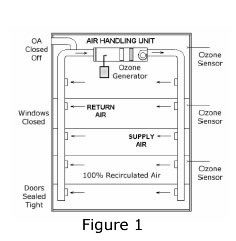Helping You Live a Healthy & Mold-free Life
Mold Inspection
We offer exceptional mold remediation services. Certified Mold Treatment and removal will come into your building and inspect it for any visible mold and all areas where mold can grow. This mold inspection includes A/C ducts, building foundations, overhead areas (i.e.) attics, hanging ceiling tiles, and all open areas and carpeting. You will be asked to fill out an agreement for mold test and sampling. We send these samples to a certified lab to analyze what kind of mold is growing in your building.
Mold Removal
The Procedure for Ozonating a Structure for mold removal are as follows:
Figure #1 illustrates the setup of an ozone mold removal remediation system. The outside air intakes must be closed, as well as the doors and windows. The ozone generator could inject ozone directly into the duct or air-handling unit. Ozone sensors should be distributed around the building to ensure that sufficient levels of ozone are reached.
Monitoring of the ozone levels does require high-end sensors. CMT uses those with accuracy and sensitivity in the range of 1-10 PPM, such as the one shown here.

Blower Door Testing Certified
Info coming soon!
Why Ozone Mold Removal
Mold Removal with Ozone as well as, fungus and viruses.
Ozone is a form of oxygen that can sterilize MOLD spores in a matter of hours. Mold Removal with Ozone can be used at higher levels inside enclosed rooms or buildings for Anthrax or other DEADLY FORMS OF PATHOGENIC MATERIAL.
Ozone tends to break down rapidly in air, especially in sunlight or in high humidity. It rapidly converts back into oxygen from whence it was made.
Ozone can be generated fairly easily with various types of ozone generators like the one shown. Some of these units, like those used for industrial water disinfection, can produce over 1500 ppm.
Ozone is a naturally occurring gas created from oxygen. The oxygen molecule is made up of 2 oxygen atoms. These oxygen molecules are broken into atoms by the Corona Discharge o3 Generator. Single oxygen atoms cannot exist alone without regrouping back into diatomic oxygen molecules. During this recombination stage, some atoms will regroup into loosely bonded tri-atomic oxygen. This new molecule is called Ozone or O3
Ozone for mold removal
Due to the loose bond in this oxygen molecule – 03 is a very strong oxidant and an ideal chemical-free purification and disinfecting agent. The most effective way to produce ozone commercially is through the use of pulse injected corona discharge. Disinfection by tri-atomic oxygen occurs through the rupture of the cell wall.
Mold removal with O3 is a more efficient method than Chlorine, which depends upon diffusion into the cell protoplasm and inactivation of the enzymes. An O3 level of 0.4 PPM for 4 minutes has been shown to remove any bacteria, virus, mold, and fungus. 1 part per million is equivalent to: 8.345 pounds per million gallons (US). At high levels, the sanitizing effect increases dramatically. For complete disinfection, a surplus or residual O3 has to be maintained in the air to assure that every living microorganism has been contacted.
O3 is very effective in attacking mold, mildew, and mold spores. At high levels, O3 deteriorates the cell structure of these microorganisms and breaks down their ability to reproduce. As the generator fills the entire space with ozone, every interior surface, including floors, ceilings, closets, furniture, and clothing, gets sanitized. While O3 is unable to pass through solid walls, it goes where normal air can go, even down into cracks and crevices.
If the area smells musty, there’s a good chance that live mold spores are in the air. These spores can reproduce by the millions creating health issues and damaging the building and its contents. Shock treatment remediation is required to remove mold odor because mold and mildew thrive in damp environments and those areas with poor air circulation.

